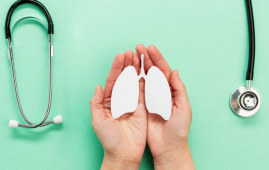

Lots of diet plans have come and gone (cabbage soup diet, anyone?) — but DASH is here to stay. The DASH eating plan (or DASH diet) has been around for decades because it has solid science to prove that it works.
Dive into what the DASH diet is and how you can use it to boost your health with dietitian Kate Patton, MEd, RD, CSSD, LD.
What is the DASH diet?
DASH stands for Dietary Approaches to Stop Hypertension. This eating plan was designed to lower the risk of hypertension (high blood pressure). High blood pressure affects 1 in 3 American adults and is a major risk factor for heart disease.
When you follow the DASH diet, you consume higher amounts of potassium — a heart-healthy mineral. You also consume less sodium, which can help lower your blood pressure and improve heart health.
The benefits of DASH are well-documented. Multiple studies have found that people who follow DASH can lower their blood pressure within a few weeks, says Patton.
But it’s not just about improving blood pressure. The DASH diet can help you lose excess weight and cut your risk for certain health problems. Research has found that following DASH could lower your risk of:
- Breast cancer.
- Colorectal cancer.
- Metabolic syndrome, a group of conditions that raises the risk of Type 2 diabetes, heart disease and stroke.
The best part about the DASH diet? It’s flexible. “It doesn’t require special foods and you don’t have to go hungry or eliminate treats,” notes Patton. Instead, DASH recommends incorporating heart-healthy foods into your daily life.
Foods to eat on DASH diet
The DASH diet focuses on eating heart-healthy foods that you can find in your grocery store. These foods are naturally high in fiber, magnesium, potassium and calcium. They’re also low in sodium.
If you follow the DASH diet, you’ll eat plenty of:
- Fruits.
- Vegetables.
- Whole grains.
- Nuts, seeds and legumes.
- Low-fat dairy.
Foods to minimize on DASH
DASH also encourages you to cut back on foods that can raise your blood pressure. These include:
- Fatty meats, such as red meat and poultry with the skin on.
- Full-fat dairy, such as whole milk, cream and butter.
- Oils that are solid at room temperature, such as coconut and palm oils.
- High-sugar foods like candy, baked goods and desserts.
- High-sugar drinks, such as soda, juice and sweetened coffee or tea.
If you follow DASH, you don’t have to eliminate these foods, says Patton. Instead, take steps toward healthier choices each day. The plan will be easier to stick with. For instance, consider replacing a meat entrée with a meatless option once a week.
Most Americans eat more meat than necessary at the expense of their vegetable intake. DASH recommends consuming no more than 6 ounces of meat per day. In its place, eat more fruits and veggies, which contain disease-fighting antioxidants, fiber and other nutrients.
DASH sodium limits
Many Americans eat too much sodium (salt). And eating a diet high in sodium can increase blood pressure and heart disease risk.
The standard DASH diet limits sodium intake to 2,300 milligrams per day. But if you want stronger results, go with the lower-sodium DASH diet. On this plan, you aim for 1,500 milligrams of sodium or less per day.
The DASH combination of nutrient-rich foods and lower sodium intake has a proven effect on blood pressure. Multiple studies have found that following the DASH diet quickly lowers blood pressure — in as little as two weeks.
Ways to cut sodium
Most of the sodium people consume doesn’t come from the saltshaker. “Processed and packaged foods are often high in salt, even if they don’t taste salty,” says Patton. Restaurant and takeout foods can also be very high in sodium.
If you’re following DASH, read food labels for sodium content and keep track of how much you’re getting. If you’re eating out, try these tips to cut back on sodium:
- Ask for the sodium content of dishes if it’s available. Request that your food be prepared without added salt, MSG or salt-containing seasonings.
- Limit or skip sauces and condiments, which tend to be high in salt, or ask for them on the side.
- Look for words that indicate high sodium: smoked, cured, pickled, soy sauce and broth.
- Choose fruits and vegetables as sides instead of salty snack foods like chips or fries.
DASH diet for weight loss
If you follow the DASH eating plan, you’ll likely shed pounds. Combine the DASH diet with calorie cutting if you want to lose more weight. Find out how many calories you should eat based on your age and activity level. Keep track of your calorie intake and cut back a little at a time.
But don’t go to extremes, cautions Patton. “If you try to cut calories quickly and dramatically, you’ll probably feel hungry and tired,” she says.
If you need help creating your weight loss plan, talk with your healthcare provider. Your doctor can help you get started or refer you to a nutritionist or dietitian.
DASH diet meal planning
A DASH diet meal plan can look different for everyone. The key is to emphasize healthy foods and sideline the less healthy ones, says Patton.
When you go to the grocery store, fill your cart with whole foods and choose boxed, bagged or canned options that are low sodium. For example, original or quick cook oats in the canister have zero milligrams of sodium, but instant oatmeal packets have sodium added.
Beans are also an important part of the DASH diet. If you don’t have time to prepare dry beans, canned beans are a good alternative. Look for no-salt-added versions, though, and be sure to rinse them.
Build your meals around foods you like that fit into the DASH plan. Don’t like green peppers? Enjoy red peppers, celery or carrots instead. Make your favorite stir fry, but use less salt, add more veggies and swap whole grain brown rice for white rice.
DASH diet recipes
Take recipes you already love and make them DASH-friendly by:
- Lowering the salt content by skipping the saltshaker and trimming back high-sodium sauces.
- Adding more veggies and fruit to your recipe.
- Reducing meat or choosing lean, skinless meats.
- Replacing butter or solid oils with unsaturated oils like olive, canola or avocado oil.
- Swapping processed white bread and grains for whole grains.
Looking for some inspiration? There are plenty of DASH-friendly recipes to explore. These tasty recipes contain higher amounts of fruits and veggies with low saturated fat and sodium.
DASH breakfast recipes
Start your day right with a nutrient-rich breakfast:
- 2-minute super-charged oatmeal: This amazing oatmeal recipe will super-charge you, too.
- Chia and berry breakfast pudding: Chia is full of nutrients and makes an awesome breakfast.
- Tropical breakfast bowl: Escape to a tropical getaway at your breakfast table with this refreshing fruity bowl.
DASH lunch recipes
Skip the afternoon slump by filling up with nutritious foods on your lunch break:
- Five fantastic recipes for crunchy, flavorful salads: Salads are so much more than lettuce. Here’s how to make salads exciting.
- Quick and hearty black bean soup: This recipe proves soup can be flavorful and filling without all the salt.
- A cool twist on avocado toast: It’s trendy avocado toast with a delicious addition.
DASH dinner recipes
These recipes help keep dinner simple and healthy after a long day:
- Roasted cauliflower tacos: This is a fun, healthy twist on taco Tuesday.
- Loaded, flavorful vegetable rice: Try a satisfying, meat-free dinner option.
- Turkey burgers with apples, onions and peppers: Enjoy this healthy take on burgers.
Pairing exercise with DASH
If you want to increase your weight loss and health benefits, pair the DASH plan with more movement and activity, says Patton.
This doesn’t mean you have to join a gym or start hard-core training. Instead, aim for at least 30 minutes of exercise a day. Walking, biking and swimming are all good options. And you don’t have to do it all at once. Break it up into two 15-minute chunks or three 10-minute chunks.
You’ll boost your health even more if you get 60 minutes of moderate-intensity exercise five days a week. Moderate intensity means your heart rate is about 50% higher than your resting heart rate. There are endless options for moderate-intensity exercise, from taking a brisk walk to swimming laps or playing basketball.
Other lifestyle changes to consider
These steps can also boost your heart health:
- Limit alcohol intake: If you drink, limit it to one drink per day for women and two drinks per day for men.
- Don’t smoke: If you don’t smoke, don’t start. If you do, try to quit. Ask your doctor if you need help quitting.
- Get enough sleep: Aim for at least seven hours of sleep each night.
Gradual change is powerful
You don’t have to follow DASH perfectly to reap its benefits. “Each day, take small steps toward healthier eating,” says Patton. “Over time, you’ll start to feel better and lose weight, which can motivate you to keep going.”
The flexibility of DASH makes healthy eating fit in with your tastes and lifestyle. And that helps you stick with it for the long-term.
more recommended stories
 Kaempferol: A Breakthrough in Allergy Management
Kaempferol: A Breakthrough in Allergy ManagementKaempferol, a dietary flavonoid found in.
 Early Milk Cereal Drinks May Spur Infant Weight Gain
Early Milk Cereal Drinks May Spur Infant Weight GainNew research published in Acta Paediatrica.
 TaVNS: A Breakthrough for Chronic Insomnia Treatment
TaVNS: A Breakthrough for Chronic Insomnia TreatmentA recent study conducted by the.
 First-of-Its-Kind Gene-Edited Pig Kidney: Towana’s New Life
First-of-Its-Kind Gene-Edited Pig Kidney: Towana’s New LifeSurgeons at NYU Langone Health have.
 Just-in-Time Training Improves Success & Patient Safety
Just-in-Time Training Improves Success & Patient SafetyA study published in The BMJ.
 ChatGPT Excels in Medical Summaries, Lacks Field-Specific Relevance
ChatGPT Excels in Medical Summaries, Lacks Field-Specific RelevanceIn a recent study published in.
 Study finds automated decision minimizes high-risk medicine combinations in ICU patients
Study finds automated decision minimizes high-risk medicine combinations in ICU patientsA multicenter study coordinated by Amsterdam.
 Study Discovers Connection Between Omicron Infection and Brain Structure Changes in Men
Study Discovers Connection Between Omicron Infection and Brain Structure Changes in MenA recent study in the JAMA.
 Advancing COPD Prognosis: Deep Learning Models
Advancing COPD Prognosis: Deep Learning ModelsResearchers conducted a meta-analysis in a.
 4 in 1 Test for Swine Flu, COVID-19, RSV, and Influenza
4 in 1 Test for Swine Flu, COVID-19, RSV, and InfluenzaIn the United Kingdom, the first.

Leave a Comment